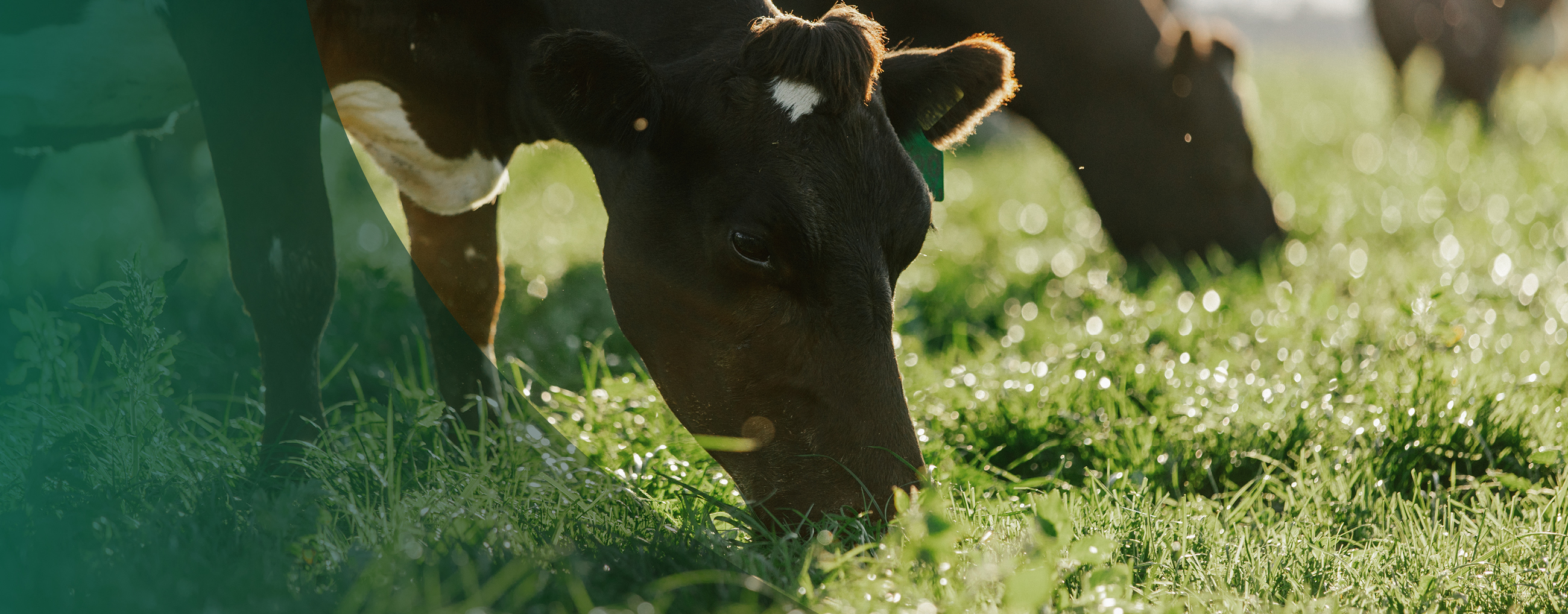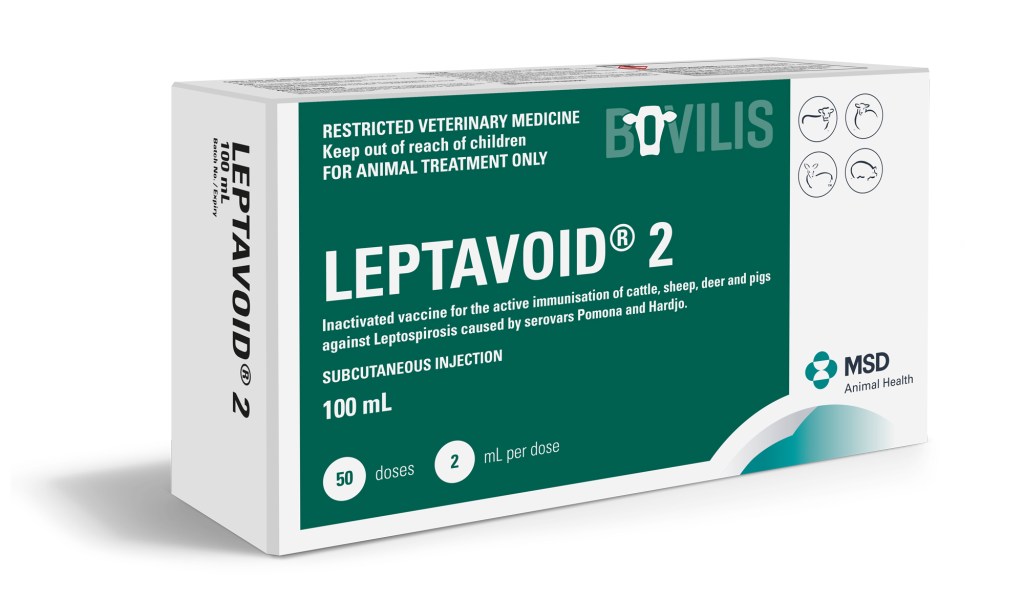
Protect your farm and your family from leptospirosis
Leptavoid® 2 – Leptospiral Vaccine
Leptavoid 2 is the only leptospiral vaccine developed, researched and trialled under New Zealand conditions for New Zealand farmers.
New Zealand has one of the highest rates of leptospirosis in the world. Leptospirosis is an infectious disease transmitted from animals to humans (a zoonosis) and from animal to animal mainly by infected urine. Meat processing workers, farmers, farm workers and veterinarians are the main groups at risk. Human leptospirosis is less likely to be seen where animals have been vaccinated.

Administering Leptavoid 2
PRIMARY VACCINATION FOR CATTLE, SHEEP AND DEER
Two 2mL doses administered 4-6 weeks apart
BOOSTER VACCINATION FOR CATTLE, SHEEP AND DEER
A 2mL booster dose is required within 12 months of the primary vaccination and annually thereafter
- Available in 100mL (50 dose) and 500mL (250 dose)
- Vaccinate subcutaneously in the anterior half of the neck
- Inactivated vaccine for the active immunisation of cattle, sheep, deer and pigs against Leptospirosis caused by serovars Pomona and Hardjo
CONCURRENT VACCINATION
Leptavoid 2 can be administered at the same time as either Covexin® 10 or Multine® without risk of detrimental immune response. Use alternative sites for administration. For more information on Animal Health Management, visit the Top Farmers Know How website.
About leptospirosis
Leptospirosis (Lepto) is an infectious disease transmitted from animals to humans (a zoonosis), and from animal to animal, through cuts or cracks in the skin or through the mucous membranes of the eyes, nose or mouth. Infection can occur in almost all warm-blooded mammals, including farm (sheep, cattle , deer and pigs), domestic (dogs) and feral animals (e.g. rats and mice).
Leptospirosis is caused by bacteria in the genus Leptospira. Infected animals shed bacteria in their urine.
In humans: Symptoms can range from minor flu-like symptoms to serious illness needing hospital admission, such as meningitis and kidney or lung failure. In some cases it may be fatal. Always seek medical attention immediately (within 24 hours) if there has been suspected exposure or if flu like symptoms develop. Ensure to tell the doctor that leptospirosis may be the cause of your symptoms as not all doctors may be familiar with the symptoms.
In animals: The infection is often subclinical, meaning the infected animal does not appear unwell. The infection can also cause visible illness in animals, especially young animals.
Common clinical signs associated with Leptospirosis in cows
- Mastitis
- A drop in milk production
- Reproductive losses
Common clinical signs associated with Leptospirosis in calves
- Depression
- High fever
- Jaundice (yellow mucous membranes)
- Blood in the urine
Elimination of leptospirosis is difficult therefore reducing the risk of exposure is an important factor in prevention.
Ways to reduce the exposure and spread of leptospirosis include:
- Vaccination of animals on farm including farm dogs
- Personal hygiene – washing hands regularly, especially prior to eating and drinking
- Never smoke, eat or drink when handling livestock
- Cover cuts, scratches or any skin breaks with waterproof sterile dressings
- Use personal protective equipment (such as gloves, milking sleeves, aprons, gumboots and google) to prevent contact with urine, contaminated water or fluids
- Controlling rodents and possums
More information regarding Leptospirosis and its prevention is available at the following sites
Worksafe Prevention and control of leptospirosis
Leptosure. Leptospirosis in NZ
Health risks & diseases
BVD (Bovine Viral Diarrhoea) is a viral disease of cattle which is wide-spread in New Zealand. Affecting both dairy and beef herds, it is estimated that about half of herds are “actively-infected” with BVD at any given time1 and the cost of BVD to the New Zealand cattle industry is around $150 million a year.2
BVD causes pregnancy loss, diarrhoea, milk drop, and reduced growth rates. It also suppresses the immune system, making animals more susceptible to other diseases, such as pneumonia and salmonella.
Research in New Zealand and overseas shows that it pays to control BVD; it is always more cost-effective to do something than to do nothing3. Moreover, a well-executed BVD control plan will help you achieve other farm goals, like improving animal welfare, reducing antibiotic usage, and improving reproductive performance.
BVD is spread by “persistently-infected” or “PI” cattle. The key to BVD control is therefore to find and eliminate PIs from within your herd, then protect your herd from contact with outside PIs. This can be accomplished by: monitoring the herd, testing individual animals, improving biosecurity, and strategically vaccinating ‘at-risk’ cattle.
For more information about BVD, including how to test for and control BVD click here
1 Han, JH et al. (2018). Using Bayesian network modelling to untangle farm management risk factors for bovine viral diarrhoea virus infection. Preventive Veterinary Medicine. 161:75-82.
2 The BVD Management Toolkit. BVD Steering Committee
3 Weir, A. (2016). Epidemiology of BVD in New Zealand dairy herds. Massey University PhD thesis dissertation
For information about prevention with Bovilis® BVD vaccine click here
Bovine Respiratory Disease (BRD) is a complex disorder of cattle causing respiratory disease and even death. It is caused by a combination of infectious agents and stress factors (weaning, transport, mixing, weather extremes, dust, handling and change of diet) acting on susceptible cattle in paddock and more intensive systems.
Signs of BRD include:
- Fever
- Depression
- Loss of appetite
- Dullness
- Coughing
- Rapid, shallow breathing
- Watery, then purulent nasal and/or eye discharge
- Excess salivation
Due to the intensification of farming, BRD may have a larger impact on New Zealand in the future than what we have seen historically. Most cattle are susceptible to BRD at some point, and it can impact performance.
For information about prevention with Bovilis® MH+IBR vaccine click here
Neonatal diarrhoea is arguably one of the most common diseases of newborn calves worldwide. The consequences on animal welfare and those managing the calves can be devastating. The cost of mortality, poor growth and performance as well as treatment costs, all need to be considered. The infectious agents that cause neonatal calf diarrhoea are prevalent in New Zealand. In a recent survey 96% of farms in New Zealand had pathogens that can cause calf scours detected1.
For more information about calf scours and calf health in general click here
For information about prevention with Rotavec® Corona vaccine click here
Pinkeye (infectious bovine kerato-conjunctivitis, or IBK) is a bacterial infection of the eye that causes inflammation and, in severe cases, temporary or permanent blindness.
For more information about prevention with Piliguard® Pinkeye-1 Trivalent click here
Leptospirosis is an infectious disease transmitted from animals to humans (a zoonosis) and from animal to animal mainly by infected urine. Infection can occur through breaks in the skin or through the mucous membranes of the eyes, nose or mouth.
For more information about prevention with Leptavoid® 2 click here


